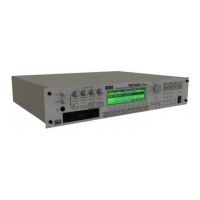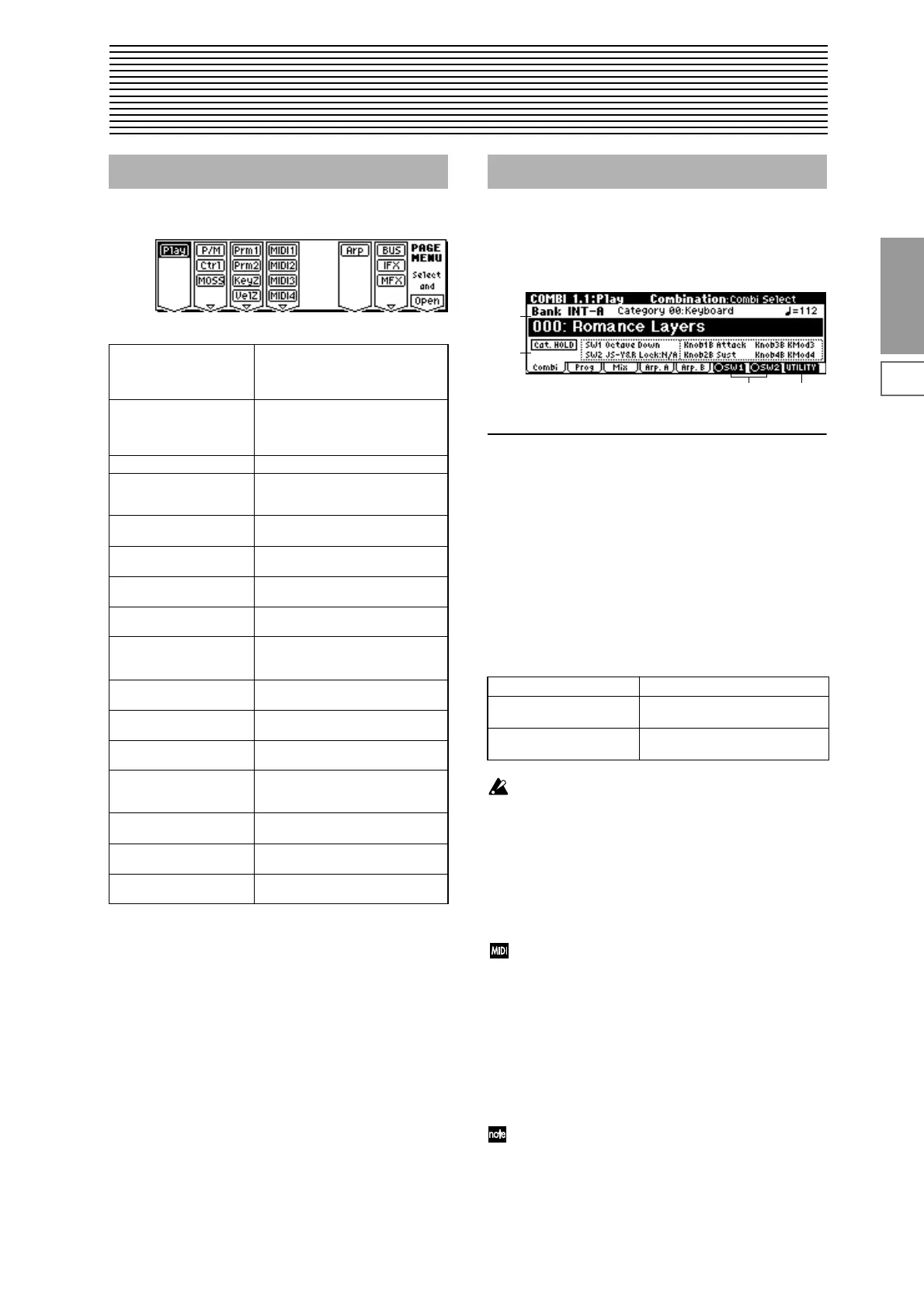31
COMBI
1.1
2.12.22.33.13.23.33.44.14.24.34.46.17.17.27.3
2. Combination mode
For details on how to select pages in Combination mode,
refer to p.1.
In this display page you can select and play Combinations.
1.1–1: Combi (Combination)
1.1–1a: Bank, Combi Select, Category, Cat.Hold,
10’s Hold,
Bank (Bank Select) [INT-A…INT-E, EXB-A...EXB-H]
This indicates the combination bank.
Use the [BANK] and [A]–[H] keys to select the bank.
To select combinations from an internal bank INT-A–INT-E,
press the [BANK] key to make the INT/EXB indicator go
dark, and press one of the [A]–[E] keys to select the bank.
To select combinations from an external bank EXB-A–EXB-
H, press the [BANK] key to make the INT/EXB indicator
light, and press one of the [A]–[H] keys to select the bank.
All banks can be rewritten. Each bank contains 128 combina-
tions, providing a total of 1,664 combination programs.
If you have selected the “Program Select” (1.1–2c) edit
cell for a timbre 1–8 in the Prog page, BANK [A]–[D]
will switch the program banks for timbres 1–8.
Combi Select (Combination Select) [0...127: name]
Select a combination. Select this parameter, and use the
[INC], [DEC] keys, numeric keys [0]–[9], or the [VALUE]
dial to select a combination. You can also select combina-
tions by category, or using “10’s Hold.” (
☞”Category,”
“Cat.HOLD,” “10’s HOLD”)
You can also select combinations by transmitting a
MIDI program change message from a connected exter-
nal MIDI device. (
☞p.221)
Category [00...15: name]
This is the combination category display.
All combinations are organized into sixteen categories. You
can select a category, and then select from combinations that
belong to that category.
To select combinations by category, use “Cat.HOLD” and
Utility “Select by Category.” (
☞PROG 1.1–1a)
To specify the category for a combination, use Utility
“Write Combination” (1.1–1d). To modify a category
name, use “Category Name Comb. 00–07, 08–15”
(GLOBAL 4.1–3/4).
COMBI PAGE MENU
Play 1.1: Play Select and play combinations. Select a
program for each timbre, and set sta-
tus, pan, and level. Select an arpeggio
pattern and make settings. (
☞p.31)
P/M 2.1: Ed-Prog/Mix Select a program for each timbre, and
set pan and level. (Same as the 1.1:
Play parameters; can be edited from
either page.) (
☞p.35)
Ctrl 2.2: Ed-Ctrl Controller settings. (
☞p.36)
MOSS 2.3: Ed-MOSS Displayed if the separately sold EXB-
MOSS option is installed. Set EXB-
MOSS parameters. (
☞p.36)
Prm1 3.1: Ed-Param1 MIDI, OSC, and Pitch settings for each
timbre. (
☞p.36)
Prm1 3.2: Ed-Param2 Delay and scale settings for each tim-
bre. (
☞p.38)
KeyZ 3.3: Ed-Key Zone Key zone settings for each timbre.
(
☞p.39)
VelZ 3.4: Ed-Vel Zone Velocity zone settings for each timbre.
(
☞p.40)
MIDI1 4.1: Ed-MIDI Filter1 MIDI message transmission/reception
filter settings for each timbre, such as
Prog Change and After Touch. (
☞p.41)
MIDI2 4.2: Ed-MIDI Filter 2 Filter settings such as JS and Ribbon
Ctrl. (
☞p.41)
MIDI3 4.3: Ed-MIDI Filter 3 Filter settings; Realtime Control Knob
(
☞p.42)
MIDI4 4.4: Ed-MIDI Filter 4 Filter settings; SW, Other Ctrl Change
(
☞p.42)
Arp 6.1: Ed-Arp Arpeggiator settings. (Same as the 1.1:
Play parameters; can be edited from
either page.) (
☞p.43)
BUS 7.1: Ed-BUS Bus and master effect send level set-
tings for each timbre. (
☞p.45)
IFX 7.2: Ed-InsertFX Insert effect routing, selection, and set-
tings. (
☞p.47)
MFX 7.3: Ed-MasterFX Master effect selection and settings.
Master EQ settings. (
☞p.48)
COMBI 1.1: Play
INT-A...INT-D (I-A...I-D) Preloaded combinations
INT-E (I-E) User combinations, EXB-MOSS com-
binations
EXB-A...EXB-H (E-A...E-H) User combinations, EXB-PCM series
combinations
1.1–1a
1.1–1b
1.1–1c 1.1–1d

